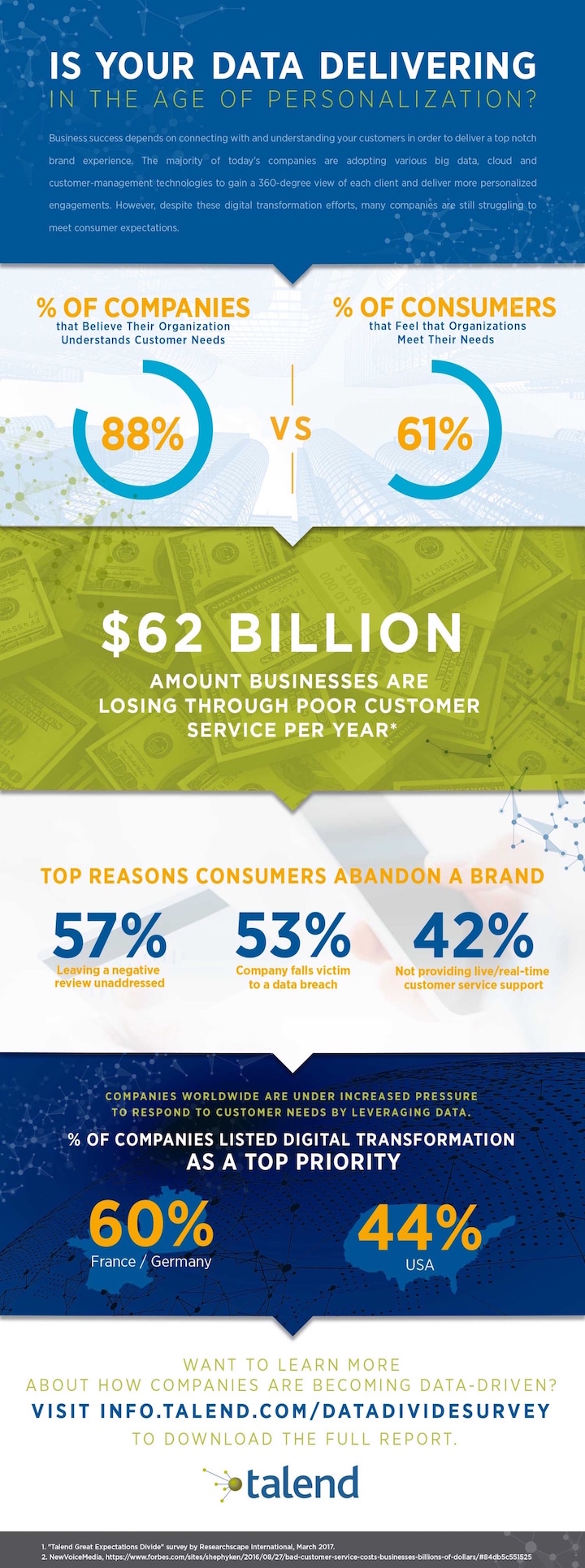New research has uncovered a startling gap between what consumers expect and what businesses are currently providing—despite a wealth of data available about customer behavior and purchasing choices, companies have a long way to go in terms of effectively using this data to better meet expectations. A new consumer and IT business survey from big data integration software Talend, conducted by Researchscape, reveals that while 88 percent of IT leaders believe their organization truly understands its customers, only 61 percent of consumers feel companies understand their needs.
Sixty-three percent of IT respondents indicated that using data to better understand customers is a top business priority for 2017, with 80 percent of companies ranking it at an eight or above on a 10-point scale. Due to the strategic nature of customer-360 initiatives, many are being led by C-Level executives: CEOs or COOs hold this responsibility at nearly half of participating companies (42% combined), followed by CIOs and CTOs (39% combined). Today’s IT organizations also recognize the importance of putting customer data in the hands of more employees, with 80 percent of surveyed companies indicating they’re making customer data accessible across multiple business units.
“Our survey shows most consumers are data driven, with 57 percent reporting they rely on data to inform buying decisions,” said Ashley Stirrup, chief marketing officer at Talend, in a news release. “While the majority of companies recognize the importance of data in driving company strategy, many are just scratching the surface when it comes to understanding the dramatic impact customer-360 initiatives can have on increasing their ‘share of wallet’ and inspiring lasting customer loyalty.”
Approximately 80 percent of IT respondents indicated their budgets have grown over the past five years. Under increasing pressure to improve the customer experience, many have invested that budget in a range of customer relationship management tools, including:
- Live chat (66%)
- Data visualization (60%)
- Speech recognition (52%)
- Retargeting tools (58%)
Despite the seemingly heavy investment by IT in customer support tools, many businesses still do not systematically track basic customer feedback. Fifty percent or less of the surveyed companies are deploying elementary barometers of customer satisfaction, such as:
- Online reviews (used by only 36% of respondents)
- Social media sentiment (utilized by only 43%); and
- Past purchase or communication preferences (employed by only 50% combined).
The consumer survey showed that online reviews have become the new word of mouth for many, with 40 percent indicating these forums have the greatest impact on large purchases—almost twice the weight of friend and family recommendations. Additionally, fifty-seven percent of respondents listed “having a negative review unaddressed while continuing to receive offers for similar products” as the top reason they would ‘break up’ with a brand. Other reasons cited by consumers for ‘breaking up’ with a company include:
- If the company falls victim to a data breach (53%)
- Not providing live/real-time customer service support (42%)
Overall, the survey suggests there is still room for organizations to use data more effectively to better understand and address customer needs. The rewards for improvement may be compelling—industry research suggests businesses are losing $62 billion per year through poor customer service. As big data and cloud tools improve, customer acquisition and retention may become increasingly competitive. Companies can seize today’s window of opportunity by optimizing customer management tools and data to keep pace with constantly evolving consumer needs, deliver top notch engagements, and maintain a competitive edge.

To better understand how companies and consumers use data and interact with each other, Talend commissioned Researchscape International to survey 361 IT leaders and 1,094 consumers in the United States, the UK, France, and Germany. For each country, participants were quota sampled to match national census data for 18 to 64-year-olds, across 32 distinct groups of gender, age range, and region.



